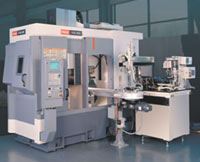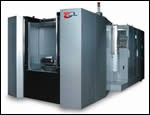Cleaning Molds: Part III
Ultrasonic immersion cleaning is a non-abrasive, user-friendly method that has the greatest impact on reducing cleaning time, improving mold cleaning consistency and reducing tooling damage.
If asked to describe the perfect cleaning system for molds and tooling that would allow a significant reduction in labor hours and tooling damage while providing consistent cleaning results, it would meet the 10 criteria listed below.
- Repair technicians would like using it.
- The cleaning method would be totally non-abrasive to all types and hardness of steel, platings, coatings and polishes.
- It would not require a repair technician to manually control or stand watch over.
- Operation would not pose a safety hazard to man, machine or the surrounding area.
- The cleaning solution would be user- and environmentally-friendly.
- The cleaning unit would be easy to clean and maintain.
- It would not be loud or irritating.
- It would have the capability to clean subassemblies and tooling contained in plates.
- Must remove 90 percent of mold fouling.
- Must not leave behind any type of residue or film on tooling or plates.
One cleaning method that comes close to meeting all of the above requirements is ultrasonic immersion cleaning. Nothing has more impact on reducing cleaning time, improving mold cleaning consistency and reducing tooling damage than this non-abrasive, user-friendly method.
What Is It?
Ultrasonic cleaning involves the use of high frequency sound waves to clean mold residues and fouling from tooling and plates that are immersed in a heated (usually 160 to 180oF) aqueous solution.
How It Works
An ultrasonic electric generator is used to convert standard line frequency current (60Hz or 50Hz) into high frequency electrical energy (20,000Hz or more). The generator is connected to small transducers that are mounted to the bottom or sides of a wash tank. These transducers vibrate at ultrasonic frequencies (20 kHz and above) when the current passes through. This causes the bottom or sides of the tank to vibrate like the diaphragm in a speaker, which creates microscopic bubbles (a phenomenon known as cavitation) to form in the tank that scrub and loosen vent residue and grime. The energy released from these microscopic scrubbing bubbles produces forces at 10,000oF at 7,500 psi, which is powerful enough to loosen contaminates without damaging critical edges or surface finishes.
Key Factors of an Ultrasonic Cleaning System
The cleaning ability of ultrasonics is dependent upon several key factors:
Cleaning Solution
The type of detergent required is dependent upon the process and type of resin you run, which leaves behind specific types of off-gassing residue.
Highly alkaline solutionsÑsuch as sodium hydroxideÑdo the best job of removing stubborn contaminates, light rust and heavy grease on most tooling and plates with no harm to most applied platings and coatings. On the downside it can be caustic, posing a potential health risk and may require neutralization before disposal, depending upon local codes.
Mild alkaline solutions also are available that perform well on many residues without the caustic issues. But in general, the friendlier the detergent, the less effective it will be on stubborn contaminates.
Slightly acidic solutionsÑsuch as those containing low concentrations of citric acidÑexcel at rust and oxide removal, but need to be used with caution on some tool steels because they can react with the iron in the steel turning it gray. This normally does not cause a problem, but doesn't sit well with toolmakers.
There also are several environmentally safe detergents being used that do a fair job removing most contaminates left from resins in use today. Combined with a minimal amount of hand scrubbing on heavily contaminated areas, these user-friendly solutions are gaining popularity with companies simply because of the ease of disposal, less mess and safer working conditions.
Ultrasonic Power and Frequency
Cleaning heavy mold plates and tooling requires the use of heavy-duty equipment and not your typical ultrasonic jewelry cleaner. The amount of power (wattage) required is dependent upon the tank size and the type of load to be cleaned. For a tank of 70 gallons (approx. 30" x 30" x 30" deep), 3000 watts @ 30 kHz performs well.
The higher the kHz rating, the less aggressive the cleaning power. Common systems use either 40 or 30 and a few use 25 and 20. 30 kHz is a good compromise between cleaning ability and noise level. Lower ratings can be extremely loud and irritating.
Transducer Type and Construction
The heart of the system, transducers come in two types: (1) magnetostrictive and (2) piezoelectric. Magnetostrictive transducers are typically more rugged and create the most aggressive cavitation action.
The best transducers also are zero-spaced and silver-brazed to the tank versus a bolted or epoxied transducer, which has more of a tendency to slowly fail over time.
Transducers may be specifically placed in the tank to correlate with the size and configuration of plates being cleaned.
Tank Design and Construction
Buy a tank large enough to totally immerse your largest mold plates. You will regret getting a small tank that will require you to flip the mold plates over for total coverage just to save a few bucks up front.
Also make sure the tank is constructed of at least 12-gauge stainless steel and be sure to have the manufacturer weld a few support bars across the bottom to keep plates and tooling baskets from directing resting on the bottom of the tank.
Purchase or build a hinged cover for the top of the wash tank to slow down the evaporation of 180-degree water.
Also fabricate a tall (about four feet) stainless back-splash that runs the length of your system and will keep your walls clean and direct any run-off back into the tanks.
When you fabricate or purchase tooling baskets be sure the handles are tall enough to extend above the surface of the hot cleaning solution and incorporate an eyehook to lift with an overhead chain hoist. Design the baskets to fit side by side across the bottom and make sure the basket material perforations are 1/4" or better so cavitation is not impeded.
Buying Considerations
In the real world, mold plates will get slammed into the sides of the wash tank and baskets full of tooling will be dropped in too fast. Exposed knobs will be ripped off. The tank will run 24/7 because everyone will suddenly have something that needs to be ultrasonically cleaned as evidenced by the grass clippings and paint residue floating on the surface. And, due to the nature of the way ultrasonic functionsÑhigh heat and constant vibrationÑsystem parts can shake loose, wear through and burn out.
Heavy-duty, bullet-proof, robust and solid all apply when shopping for an ultrasonic system that will perform reliably in a busy mold repair shop. And unless absolutely necessary, stay away from all the bells and whistles in the form of automatic loaders, conveyors, dryers and fancy cabinetry.
However, do make sure:
- The transducers are warranted for the life of the system.
- The tank is warranted for 20 years or more against cavitation wear through (which can drastically cut transducer life).
- The wash tank has a pump filtering system and is easily accessible.
- The pump intake is screened to keep small dowels, o-rings etc. from damaging the pump impeller.
- The tank drain valves are easily accessible.
- There are no protruding knobs, handles, switches or buttons.
- Tank heaters are easily accessible.
Ultrasonic Pros
- Ease of use
- Simply place the plates or tooling in the tank, set the timer, turn it on and walk away; doesn't need to be baby-sat
- Cleans the mold while repair technicians work on other issues; like doubling your workforce
- Cleans some tooling without requiring removal from plates
- Predictable and consistent results
- Cleans hard-to-access areas like counter bores, threaded holes, pockets, water lines and bubbler tubes
- Does not harm sharp edges, applied platings, coatings textured or polished surfaces
- Extremely fast ROI
Cons
- Requires light scrubbing of heavily rusted areas before immersion
- Will not remove some types of residue (using an environmental safe solution). Step up to sodium hydroxide if your cleaning requirements demand it and your local codes permit it.
- Requires really hot water 180¼ to 200¼ which won't kill you, but does get your attention
- The high frequency noise can be irritating over a period of time if working close by
Ultrasonic Benefits
To see if ultrasonics will work for you, send samples of contaminated tooling to an ultrasonic supplier as a test. This also will help the supplier match your specific contaminates with the proper detergent for efficient removal. Some suppliers will even set you up with a trial unit to use.
Once the system is installed, you will see an immediate reduction of labor hours simply because of the speed in which tooling will be cleaned compared to the laborious task of hand cleaning one piece at a time. And as a bonus, there will be no more rounded over edges, or platings and coating scrubbed off.
Related Content
Products and Services for Multiple Moldmaking Needs
New year, new technology roundup! Featured here is a collection of product offerings, from profile milling cutters to industry-specific CAD/CAM software to innovative hot work tool steels.
Read MoreQuestions and Considerations Before Sending Your Mold Out for Service
Communication is essential for proper polishing, hot runner manifold cleaning, mold repair, laser engraving and laser welding services.
Read MoreHow to Use Thermal Management to Improve Mold Cooling
A review of common mold cooling issues and possible solutions, including 3D printing applications.
Read MoreMoldMaking Technology's Most-Viewed Content 2022: Products
MMT shares the five top-viewed technologies, equipment and services of 2022 in each Engineer, Build, Maintain and Manage tenet based on Google Analytics.
Read MoreRead Next
Cleaning Molds: Part I
Cleaning a mold is a critical part of the repair process, but many myths must be dispelled.
Read MoreHow to Use Strategic Planning Tools, Data to Manage the Human Side of Business
Q&A with Marion Wells, MMT EAB member and founder of Human Asset Management.
Read More








.jpg;maxWidth=300;quality=90)
_300x250 4.png;maxWidth=300;quality=90)


















